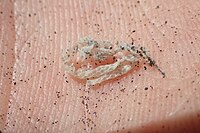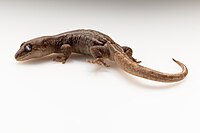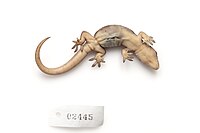
Muriwai, also called Muriwai Beach, is a coastal community on the west coast of the Auckland Region in the North Island of New Zealand. The black-sand surf beach and surrounding area is a popular recreational area for Aucklanders. The Muriwai Regional Park includes a nesting site for a large colony of gannets.

Duvaucel's gecko is a species of lizard in the family Diplodactylidae. The species is endemic to New Zealand and regarded as 'at risk' by the New Zealand Department of Conservation (DOC) due to distribution limitations.

The Auckland green gecko, also known as the elegant gecko, is a species of gecko found only in the northern half of the North Island of New Zealand, except north of Whangaroa.

Whitaker's skink, also known commonly as Whitaker's New Zealand skink, is an endangered species of skink, a lizard in the family Scincidae. The species is found only in New Zealand.
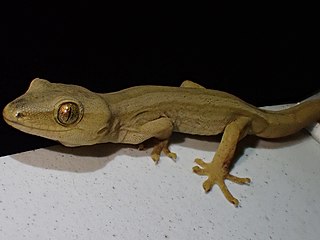
The gold-striped gecko, gold-stripe gecko, or golden sticky-toed gecko is a species of gecko in the family Diplodactylidae. It is endemic to New Zealand, and is only found in the Taranaki region and Mana Island. The holotype is in the collection of the Museum of New Zealand Te Papa Tongarewa.

The black-eyed gecko, also known commonly as Whitaker's sticky-toed gecko, is a species of lizard in the family Diplodactylidae. An alpine gecko species, discovered in 1970, it inhabits high-altitude mountains in three areas of the South Island of New Zealand. It is the highest-altitude lizard species in New Zealand, living up to 2,200 m (7,200 ft) above sea level.

The Stephen's Island gecko, also known commonly as the Cook Strait striped gecko, Stephen's sticky-toed gecko, and the striped gecko, is a species of gecko in the genus Toropuku in the family Diplodactylidae. The species is endemic to New Zealand.
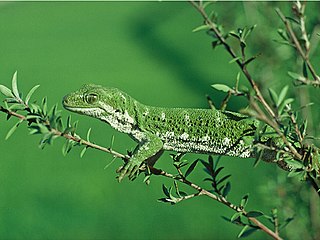
The Marlborough green gecko, also known as the manuka gecko, is a small species of gecko endemic to New Zealand. It grows to a maximum of 70mm, and is green, with some individuals displaying gold markings. The underside of the gecko is a lighter green in females, and silvery in males. The holotype is in the collection of the Museum of New Zealand Te Papa Tongarewa.

The forest gecko is a species of gecko that is endemic to New Zealand. Its Māori name is moko pirirākau. It is found in all parts of the country except the Far North and Canterbury. It is a protected species under the Wildlife Act 1953.

Woodworthia maculata, also known as the New Zealand common gecko or Raukawa gecko, is a species in the family Diplodactylidae. The species is endemic to New Zealand.

The Tākitimu gecko is an endemic species of gecko in the family Diplodactylidae found in the Southland region of New Zealand. Tākitimu gecko were first described by Jewell and Leschen in 2004 as Hoplodactylus cryptozoicus.
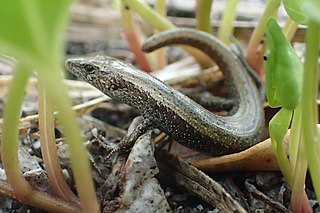
Oligosoma smithi, commonly known as the shore skink, short-tailed skink, Smith's ground skink, Smith's moco, and Smith's skink, is a species of lizard in the family Scincidae (skinks) that is native to New Zealand.

Woodworthia is a genus of geckos in the family Diplodactylidae endemic to New Zealand. It includes four formally described species, though as many as 17 genetically distinct species may exist. All species are native to New Zealand.

Te Korowai-o-Te-Tonga Peninsula, also known as South Head and by its former name of the South Kaipara Peninsula, is a long peninsula in the North Island of New Zealand, extending north along the western edge of the Kaipara Harbour for some 35 kilometres (22 mi) from near Helensville to the harbour's mouth. The peninsula was officially renamed in 2013 as part of a Treaty of Waitangi settlement. The name, which is Māori for "The cloak of the south", reflects the peninsula's geographical role in guarding the southern half of the Kaipara Harbour from the Tasman Sea and prevailing westerly winds. The mouth of the Kaipara Harbour separates the peninsula from the larger Pouto Peninsula to the north.

The Alborn skink is a critically endangered and poorly known species of skink only found in a single 2 ha site near Reefton, New Zealand. It is classified as "Nationally Critical" by the Department of Conservation under the New Zealand Threat Classification System.

Muriwai Regional Park is a regional park located in Muriwai on the west coast of the Auckland Region of New Zealand's North Island. It is situated in Rodney north-west of Auckland and is owned and operated by Auckland Council.

Oaia Island is an island on the west coast of the Auckland Region, New Zealand, near Muriwai. Home to an Australasian gannet colony, the island was traditionally used as a seasonal food resource for Tāmaki Māori iwi, including Te Kawerau ā Maki. Over the 21st century, the gannet population grew significantly, which had a negative impact on the island's flora, and led to gannets colonising areas of the Muriwai mainland. The island is a known location where the rare korowai gecko has been found.

Stephen Ernest Thorpe was an English-born entomologist in New Zealand. He contributed vast amounts of data and analysis in many contexts, particularly to iNaturalist. Thorpe was a member of the research group that described the beetle genus Neodoxa in 2003. In 2011, he helped with describing the New Zealand marsh beetle species Stenocyphon neozealandicus by recognising the species among unsorted insect specimens at Auckland War Memorial Museum while he was volunteering. Thorpe was murdered on 24 August 2024 during his daily walk to search for insects and plants. Thirteen species were named after Thorpe.
The tātahi skink is an undescribed skink species endemic to New Zealand in the family Scincidae, found on the western coast of the Northland Peninsula and Manawatāwhi / Three Kings Islands in New Zealand. Thought to be the same species as Oligosoma smithi of the east coast, the Tātahi skink was identified as being genetically distinct in 2008.




